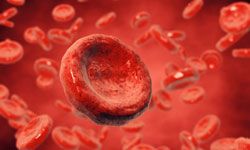Luspatercept Reduces Anemia Severity in Lower-Risk Myeolodyplastic Syndromes
A new phase III trial has found that luspatercept reduced the severity of anemia in patients with transfusion-refractory, lower-risk myelodysplastic syndromes with ring sideroblasts. Results from the MEDALIST trial, which included data from 65 sites in 11 countries, were published recently in the New England Journal of Medicine.

A new phase III trial has found that luspatercept (Reblozyl) reduced the severity of anemia in patients with transfusion-refractory, lower-risk myelodysplastic syndromes with ring sideroblasts. Results from the MEDALIST trial (NCT02631070), which included data from 65 sites in 11 countries, were published recently in theNew England Journal of Medicine.
After 24 weeks of treatment, nearly 4 in 10 of the patients in the luspatercept group achieved transfusion independence for 8 weeks or longer (n = 58, 38%). This compared with 13% of those in the placebo group (n = 10;P<0.001).
Similarly, a higher percentage of patients in the luspatercept group achieved transfusion independence for 12 weeks or longer than those who received placebo. For weeks 1-24, this was 28% of the experimental group vs. 8%. For weeks 1-48, 33% of the experimental group achieved 12-week independence vs. 12% (P<0.001 for both comparisons).
“The MEDALIST trial focused on patients with lower-risk myelodysplastic syndromes with ring sideroblasts because this is the largest subgroup of patients with myelodysplastic syndromes who have a low risk of progression to acute myeloid leukemia as well as prolonged survival, and therefore the treatment of anemia is particularly important in these patients,” wrote the authors, led by Pierre Fenaux, MD, PhD, of the Hopital Saint-Louis in Paris.
“Although there were potential differences in the criteria for response assessment between our trial and previous studies, luspatercept resulted in a higher percentage of patients with a response or a better safety profile (or both) than were seen with previously evaluated treatments in patients with disease that was refractory or resistant to erythropoiesis-stimulating agents who had non-del(5q) transfusion-dependent lower-risk myelodysplastic syndromes,” they wrote.
MEDALIST enrolled adult patients who had a myelodysplastic syndrome with ring sideroblasts according to World Health Organization criteria (either ≥15% ring sideroblasts or ≥5% ring sideroblasts if anSF3B1mutation was present, and with <5% bone marrow blasts). Eligible patients were refractory to erythropoiesis-stimulating agents or had discontinued them due to a previous adverse event.
The primary end point was transfusion independence for 8 weeks or longer during weeks 1 through 24. The authors selected this interval to reduce potential bias due to loss of patients receiving placebo without an early response. The key secondary end point was transfusion independence for 12 weeks or longer.
Patients were randomized 2:1 to receive luspatercept or placebo. The trial drug was given subcutaneously every 3 weeks for 24 weeks. The starting dose of luspatercept was 1.0 mg per kilogram of body weight. The dose was increased to 1.33 mg per kilogram and then to 1.75 mg per kilogram for patients who required a new transfusion after achieving transfusion independence.
At the week 25 disease assessment, patients who were not receiving clinical benefit from treatment entered follow-up. At that time, patients who did benefit clinically and whose disease had not progressed could enter the extension phase and continue receiving double-blinded luspatercept or placebo until disease progression or unacceptable toxicity.
Of 229 enrolled patients, 153 were randomized to receive luspatercept and 76 to receive placebo. Baseline characteristics were well-balanced and, although patients ranged in age from 26 to 95, the median age was 71. Nearly three-quarters of patients were found to have low-risk disease (72%), while 10% had very low risk disease and 17% had intermediate-risk disease. At baseline, 93% of experimental group patients were found to haveSF3B1mutations, while 86% of controls did.
During the first 24 weeks, nearly two-thirds of lustapatercept patients who responded had at least 2 response intervals of transfusion independence lasting 8 weeks or longer (n = 36, 62%). Conversely, all placebo group patients who responded had two or fewer response intervals during that time.
Almost all luspatercept responders had their first response at the starting dose of 1.0 mg per kilogram (n = 52, 90%). Two patients each didn’t respond until their doses were raised to 1.33 mg/kg and 1.75 mg/kg, respectively.
During the first 24 weeks, 43 patients (28%) in the luspatercept group had transfusion independence for 12 weeks or longer, as compared with 6 (8%) in the placebo group (P<.001). For the full 48-week evaluation period, 51 patients (33%) in the luspatercept group achieved 12-week independence, while only 9 patients (12%) in the placebo group did (P<.001).
At data cutoff, 46% of the patients were continuing to receive luspatercept and 8% were continuing to receive placebo. The longest single period of transfusion independence was a median of 30.6 weeks in the luspatercept group and 13.6 weeks in the placebo group. A smaller number of patients were able to maintain transfusion independence for 1 year, including 22 patients (14%) in the luspatercept group.
Fenaux et al found that luspatercept was associated with mainly low-grade toxic effects that seldom led to the discontinuation of treatment and that the incidence of adverse effects generally decreased over time among luspatercept-treated patients. “Although the trial was underpowered for the systematic analysis of progression to acute myeloid leukemia, the incidence was low in both groups and consistent with the natural history of lower-risk myelodysplastic syndromes with ring sideroblasts; long-term follow-up is ongoing,” they wrote.
Among patients who had a baseline transfusion burden of 4-5 units per 8 weeks, 37% of those in the luspatercept group and 4% of those in the placebo group had a response. “Although the precise mechanism of action of luspatercept on SMAD2 and SMAD3 signaling remains incompletely understood, the rapid onset of treatment effect, extended duration of transfusion independence, erythroid response, and increased hemoglobin levels suggest that luspatercept had useful clinical effects in these patients,” Fenaux et al wrote.
Reference:
Fenaux P, Platzbecker U, Mufti GJ, et al. Luspatercept in Patients with Lower-RiskMyelodysplastic Syndromes. N Engl J Med. 2020;382:140-51.DOI: 10.1056/NEJMoa1908892









